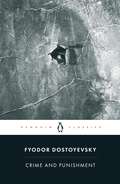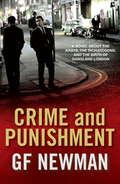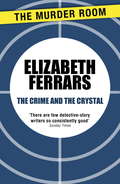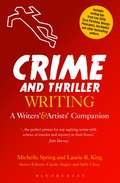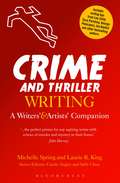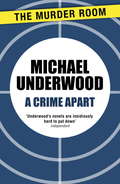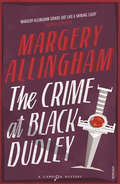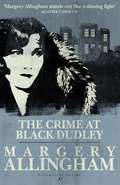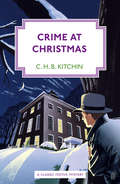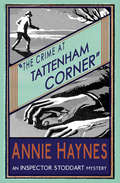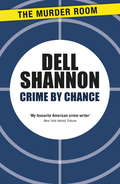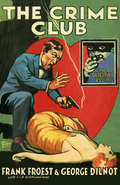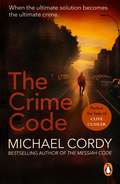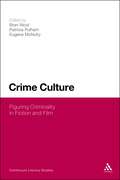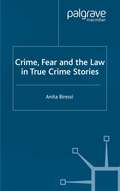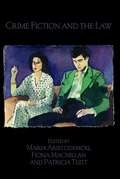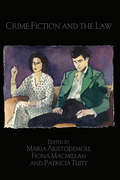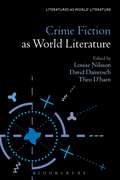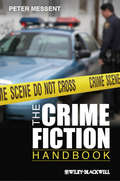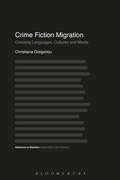- Table View
- List View
Crime and Punishment: A Play In Three Acts (Illustrated Classics Collection)
by Fyodor Dostoyevsky'Dostoyevsky's finest masterpiece' John BayleyDostoyevsky's great novel of damnation and redemption evokes a world where the lines between innocence and corruption, good and evil, blur. It tells the story of Raskolnikov, a destitute and desperate former student, who wanders through the slums of St Petersburg and commits a random murder without remorse or regret. He imagines himself to be beyond conventional moral laws. But as he embarks on a dangerous game of cat and mouse with a police investigator, Raskolnikov is pursued by the growing voice of his conscience and finds the noose of his own guilt tightening around his neck. Translated with an Introduction and notes by DAVID McDUFF
Crime and Punishment
by Fyodor Dostoyevsky Constance Garnett[This text is listed as an example that meets Common Core Standards in English language arts in grades 11-12 at http://www.corestandards.org.]
Crime and Punishment
by G.F. NewmanIn 1951 the Festival of Britain marks a new golden age of hope and prosperity for the country. Things are certainly looking up for the criminal elite who run the East End. For Jack, a draft-dodger with aspirations to be a champion boxer, there's easy money to be made for providing a bit of muscle. Meanwhile his sister Kath must keep secret the fact that she killed their father to protect her son, Brian, from the abuse she experienced as a child. Brian is so traumatised by witnessing this event that the complex union of violence and sexuality will shape his character for life. As the years go by and disillusion sets in, successive Labour and Tory governments aren't able to stop the rot. Younger, nastier criminals like the Kray twins and the Richardson brothers begin to carve out their own criminal empires and crush all resistance. Brutalised and embittered by years of failure and imprisonment, Jack decides to make a stand. The stage is set for one big war. Crime and Punishment is the first volume in a two-part epic, and follows the characters' lives up until the accession of Thatcher. The second volume will trace the dramatic changes in criminal society that reflected the wider social upheaval of the times, right up until the present day.
The Crime and the Crystal (Andrew Basnett)
by Elizabeth FerrarsChristmas in Adelaide promises to be a pleasant vacation for Andrew Basnett, retired professor of botany and amateur sleuth. But the shadow of an unsolved murder hangs over the lives of his hosts, Tony and Jan Gardiner. The police still suspect Jan of her first husband's murder - and then a second killing takes place under the same bizarre circumstances. What can a guest do in such a case but try to clear the name of his hostess and solve the crime?'Very readable' Glasgow Herald
Crime and Thriller Writing: A Writers' & Artists' Companion (Writers’ and Artists’ Companions)
by Michelle Spring Laurie R. KingCrime and Thriller Writing: A Writers' & Artists' Companion is an essential guide to writing in these exciting genres. PART 1 explores the nature and history of the genre and helpsyou get started with ideas, planning and research. PART 2 includes tips by bestselling crime writers: Mark Billingham, S.J. Bolton, Alafair Burke, Lee Child, N. J. Cooper, Meg Gardiner, Tess Gerritsen, Sophie Hannah, Jim Kelly, Laura Lippman, Gayle Lynds, Alex McBride, Val McDermid, Dreda Say Mitchell, Sara Paretsky, Jill Paton Walsh, George Pelecanos, Ian Rankin, Peter Robinson, S. J. Rozan, Guy Saville, Yrsa Sigurðardóttir, Dana Stabenow, Andrew Taylor, Charles Todd and Laura Wilson. PART 3 contains practical advice--from shaping plots and exploring your characters to the meaning of writer's block, the power of the rewrite, and how to find an agent when your novel is complete.
Crime and Thriller Writing: A Writers' & Artists' Companion (Writers’ and Artists’ Companions)
by Michelle Spring Laurie R. KingCrime and Thriller Writing: A Writers' & Artists' Companion is an essential guide to writing in these exciting genres. PART 1 explores the nature and history of the genre and helpsyou get started with ideas, planning and research. PART 2 includes tips by bestselling crime writers: Mark Billingham, S.J. Bolton, Alafair Burke, Lee Child, N. J. Cooper, Meg Gardiner, Tess Gerritsen, Sophie Hannah, Jim Kelly, Laura Lippman, Gayle Lynds, Alex McBride, Val McDermid, Dreda Say Mitchell, Sara Paretsky, Jill Paton Walsh, George Pelecanos, Ian Rankin, Peter Robinson, S. J. Rozan, Guy Saville, Yrsa Sigurðardóttir, Dana Stabenow, Andrew Taylor, Charles Todd and Laura Wilson. PART 3 contains practical advice--from shaping plots and exploring your characters to the meaning of writer's block, the power of the rewrite, and how to find an agent when your novel is complete.
A Crime Apart (Murder Room Ser.)
by Michael UnderwoodA woman is murdered in a London suburb and the police investigation into her death is meticulously undertaken. Trying to solve the riddle is Detective Chief Inspector Chudd, newly appointed and still trying to find his feet in. When the truth finally emerges, the gallery of suspects includes the lady next door, a clock-winder, the ex-lodger, a Canadian heiress and two 'bovver boys'. This is as much a story about detection and detectives as it is about the brutal crime itself. 'As always, splendid' Oxford Mail
The Crime At Black Dudley (Albert Campion Ser.)
by Margery AllinghamTHE FIRST CAMPION MYSTERY'Margery Allingham stands out like a shining light'Agatha ChristieA suspicious death and a haunted family heirloom were not advertised when Dr George Abbershaw and a groupof London's brightest young things accepted an invitation to the mansion of Black Dudley. Skulduggery is most certainly afoot, and the party-goers soon realise that they're trapped in the secluded house. Amongst them is a stranger who promises to unravel the villainous plots behind their incarceration - but can George and his friends trust the peculiar young man who calls himself Albert Campion?
The Crime at Black Dudley (Albert Campion Ser.)
by Margery AllinghamClassic Crime from the Golden Age, the first in the Albert Campion Series. Margery Allingham is J.K. Rowling's favourite Golden Age author.George Abbershaw is set for a social weekend at Black Dudley manor, hosted by Wyatt Petrie and his elderly uncle Colonel Combe, who enjoys the company of Bright Young Things. With Meggie Oliphant in attendance, George looks forward to the chance of getting closer to the girl he's set his heart on. But when murder spoils the party, the group soon find out that not only is there a killer in their midst, but the house is under the control of notorious criminals. Trapped and at their mercy, George must find a way to thwart their diabolical plans while getting himself and Meggie out alive.Luckily for Abbershaw, among the guests is Albert Campion – a garrulous and affable party-crasher with a great knack for solving mysteries and interrogating suspects.The Crime at Black Dudley, first published in 1929, is the first novel to introduce Margery Allingham's amiable and much loved sleuth – Albert Campion.
Crime at Christmas
by C. H. Kitchin'There we were, all gathered together for a Christmas party, and plunged suddenly into gloom.'It's Christmas at Hampstead's Beresford Lodge. A group of relatives and intimate friends gather to celebrate the festive season, but their party is rudely interrupted by a violent death. It isn't long before a second body is discovered. Can the murderer be one of those in the great house? The stockbroker sleuth Malcolm Warren investigates, in this brilliantly witty mystery.'Kitchin's knowledge of the crevices of human nature lifts his crime fiction out of the category of puzzledom and into the realm of the detective novel. He was, in short, ahead of his day.' H. R. F. Keating
The Crime at Tattenham Corner: An Inspector Stoddart Mystery
by Annie HaynesThe body lay face downwards in a foot of water at the bottom of the ditch. Up to the present it has not been identified. But a card was found in the pocket with the name of –The grisly discovery was overshadowed in the public imagination by Derby Day, the most prestigious event in the English horse-racing calendar. But Peep o’ Day, the popular favourite for the Derby and owned by the murdered man, won’t run now. Under Derby rules, the death means automatic disqualification.Did someone find an ingenious if ruthless way to stop the horse from competing? Or does the solution to the demise of Sir John Burslem lie away from the racetrack? The thoughtful Inspector Stoddart starts to investigate in a crowded field of sinister suspects and puzzling diversions.The Crime at Tattenham Corner was the second of the four Inspector Stoddart mysteries, first published in 1928. This new edition features an introduction by crime fiction historian Curtis Evans.“We not only encounter thrilling surprises but are introduced to many admirably life-like characters. Miss Haynes is here at her best. Excellent as a detective tale, the book is also a charming novel.” Spectator
Crime By Chance
by Dell ShannonWith a brief note to her employer, Dorrie Mayo left her job - and another note taped to a neighbour's door claimed she was taking her baby to live with her in-laws on the other side of the U.S. A natural enough thing for a young widow with a fifteen-month-old daughter to do.Only why didn't Dorrie tell any of her friends where she was going? And why were her notes typewritten when Dorrie didn't own a typewriter? For Maddox and his colleagues of the Wilcox Street precinct, this is a conundrum that will take all their skill and resources to solve.
The Crime Club (Detective Club Crime Classics)
by Frank Froest George DilnotThe Detective Story Club’s first short story anthology is based around a London detective club and includes three newly discovered tales unpublished for 100 years, plus a story bearing an uncanny resemblance to a Conan Doyle Sherlock Holmes story but written some seven years earlier.
The Crime Code: a tense and thought-provoking thriller that you do not want to miss
by Michael CordyThe year is 2008. Violent crime has become a global epidemic, nowhere more so than in the United States. Everything from the death penalty to liberal reforms has failed. Nothing has been effective. Until now.Project Conscience promises to be the solution. It is a bold attempt by a powerful group of scientists, politicians and senior law-enforcement personnel to use gene therapy to treat male criminals and cure violent crime. But among their number are those with a more sinister agenda, who would go further and turn the dream of Project Conscience into the nightmare of Crime Zero.Luke Decker, a criminal psychologist disillusioned with the growing dependence on genetic science, is on the verge of resigning from the FBI when a death-row killer's whispered revelation threatens everything he believes in and catapults him into the heart of the conspiracy. Decker's only ally is Dr Kathy Kerr, an old flame and ideological adversary, and the geneticist behind the original Project Conscience.Together they must put aside their differences to fight against a scheme so ruthless in intent and so vast in scope that it will irrevocably change the evolution of mankind itself.Crime Zero is a terrifyingly credible thriller based on technological developments that are already with us. At its core is the story of one man's desperate fight for self-determination and free will in a world where such qualities are in danger of imminent extinction . . .
Crime Culture: Figuring Criminality in Fiction and Film
by Bran Nicol Eugene McNulty Patricia PulhamBy broadening the focus beyond classic English detective fiction, the American 'hard-boiled' crime novel and the gangster movie, Crime Culture breathes new life into staple themes of crime fiction and cinema.Leading international scholars from the fields of literary and cultural studies analyze a range of literature and film, from neglected examples of film noir and 'true crime', crime fiction by female African American writers, to reality TV, recent films such as Elephant, Collateral and The Departed, and contemporary fiction by J. G. Ballard, Kazuo Ishiguro, and Margaret Atwood. They offer groundbreaking interpretations of new elements such as the mythology of the hitman, technology and the image, and the cultural impact of 'senseless' murders and reveal why crime is a powerful way of making sense of the broader concerns shaping modern culture and society.
Crime, Fear and the Law in True Crime Stories (Crime Files)
by Anita BiressiWhy do true crime stories exert such popular fascination? What do they have to say about the fear of crime in the present moment? This book examines the historical origins and development of true crime and its evolution into distinctive contemporary forms. Embracing a range of non-fiction accounts - true crime book and magazines, law and order television, popular journalism - it traces how they harness and explore current concerns about law and order, crime and punishment and personal vulnerability.
Crime Fiction And The Law
by Maria Aristodemou Fiona Macmillan Patricia TuittThis book opens up a range of important perspectives on law and violence by considering the ways in which their relationship is formulated in literature, television and film. Employing critical legal theory to address the relationship between crime fiction, law and justice, it considers a range of topics, including: the relationship between crime fiction, legal reasoning and critique; questions surrounding the relationship between law and justice; gender issues; the legal, political and social impacts of fictional representations of crime and justice; post-colonial perspectives on crime fiction; as well as the impact of law itself on the crime fiction’s development. Introducing a new sub-field of legal and literary research, this book will be of enormous interest to scholars in critical, cultural and socio-legal studies, as well as to others in criminology, as well as in literature.
Crime Fiction and the Law (Birkbeck Law Press)
by Maria Aristodemou Fiona Macmillan Patricia TuittThis book opens up a range of important perspectives on law and violence by considering the ways in which their relationship is formulated in literature, television and film. Employing critical legal theory to address the relationship between crime fiction, law and justice, it considers a range of topics, including: the relationship between crime fiction, legal reasoning and critique; questions surrounding the relationship between law and justice; gender issues; the legal, political and social impacts of fictional representations of crime and justice; post-colonial perspectives on crime fiction; as well as the impact of law itself on the crime fiction’s development. Introducing a new sub-field of legal and literary research, this book will be of enormous interest to scholars in critical, cultural and socio-legal studies, as well as to others in criminology, as well as in literature.
Crime Fiction and the Law (Birkbeck Law Press)
by Maria Aristodemou Fiona Macmillan Patricia TuittThis book opens up a range of important perspectives on law and violence by considering the ways in which their relationship is formulated in literature, television and film. Employing critical legal theory to address the relationship between crime fiction, law and justice, it considers a range of topics, including: the relationship between crime fiction, legal reasoning and critique; questions surrounding the relationship between law and justice; gender issues; the legal, political and social impacts of fictional representations of crime and justice; post-colonial perspectives on crime fiction; as well as the impact of law itself on the crime fiction’s development. Introducing a new sub-field of legal and literary research, this book will be of enormous interest to scholars in critical, cultural and socio-legal studies, as well as to others in criminology, as well as in literature.
Crime Fiction and the Law (PDF)
by Maria Aristodemou Fiona Macmillan Patricia TuittThis book opens up a range of important perspectives on law and violence by considering the ways in which their relationship is formulated in literature, television and film. Employing critical legal theory to address the relationship between crime fiction, law and justice, it considers a range of topics, including: the relationship between crime fiction, legal reasoning and critique; questions surrounding the relationship between law and justice; gender issues; the legal, political and social impacts of fictional representations of crime and justice; post-colonial perspectives on crime fiction; as well as the impact of law itself on the crime fiction’s development. Introducing a new sub-field of legal and literary research, this book will be of enormous interest to scholars in critical, cultural and socio-legal studies, as well as to others in criminology, as well as in literature.
Crime Fiction as World Literature (Literatures as World Literature)
by David Damrosch Theo D'haen Louise NilssonWhile crime fiction is one of the most widespread of all literary genres, this is the first book to treat it in its full global is the first book to treat crime fiction in its full global and plurilingual dimensions, taking the genre seriously as a participant in the international sphere of world literature. In a wide-ranging panorama of the genre, twenty critics discuss crime fiction from Bulgaria, China, Israel, Mexico, Scandinavia, Kenya, Catalonia, and Tibet, among other locales. By bringing crime fiction into the sphere of world literature, Crime Fiction as World Literature gives new insights not only into the genre itself but also into the transnational flow of literature in the globalized mediascape of contemporary popular culture.
Crime Fiction as World Literature (Literatures as World Literature)
by David Damrosch Theo D'haen Louise NilssonWhile crime fiction is one of the most widespread of all literary genres, this is the first book to treat it in its full global is the first book to treat crime fiction in its full global and plurilingual dimensions, taking the genre seriously as a participant in the international sphere of world literature. In a wide-ranging panorama of the genre, twenty critics discuss crime fiction from Bulgaria, China, Israel, Mexico, Scandinavia, Kenya, Catalonia, and Tibet, among other locales. By bringing crime fiction into the sphere of world literature, Crime Fiction as World Literature gives new insights not only into the genre itself but also into the transnational flow of literature in the globalized mediascape of contemporary popular culture.
The Crime Fiction Handbook (Wiley Blackwell Literature Handbooks)
by Peter MessentThe Crime Fiction Handbook presents a comprehensive introduction to the origins, development, and cultural significance of the crime fiction genre, focusing mainly on American British, and Scandinavian texts. Provides an accessible and well-written introduction to the genre of crime fiction Moves with ease between a general overview of the genre and useful theoretical approaches Includes a close analysis of the key texts in the crime fiction tradition Identifies what makes crime fiction of such cultural importance and illuminates the social and political anxieties at its heart. Shows the similarities and differences between British, American, and Scandinavian crime fiction traditions
The Crime Fiction Handbook (Wiley Blackwell Literature Handbooks)
by Peter MessentThe Crime Fiction Handbook presents a comprehensive introduction to the origins, development, and cultural significance of the crime fiction genre, focusing mainly on American British, and Scandinavian texts. Provides an accessible and well-written introduction to the genre of crime fiction Moves with ease between a general overview of the genre and useful theoretical approaches Includes a close analysis of the key texts in the crime fiction tradition Identifies what makes crime fiction of such cultural importance and illuminates the social and political anxieties at its heart. Shows the similarities and differences between British, American, and Scandinavian crime fiction traditions
Crime Fiction Migration: Crossing Languages, Cultures and Media (Advances in Stylistics)
by Christiana GregoriouCrime narratives form a large and central part of the modern cultural landscape. This book explores the cognitive stylistic processing of prose and audiovisual fictional crime 'texts'. It also examines instances where such narratives find themselves, through popular demand, 'migrating' - meaning that they cross languages, media formats and/or cultures.In doing so, Crime Fiction Migration proposes a move from a monomodal to a multimodal approach to the study of crime fiction. Examining original crime fiction works alongside their translations, adaptations and remakings proves instrumental in understanding how various semiotic modes interact with one another. The book analyses works such as We Need to Talk About Kevin, The Killing trilogy and the reimaginings of plays such as Shear Madness and films such as Funny Games.Crime fiction is consistently popular and 'on the move' - witness the spate of detective series exported out of Scandinavia, or the ever popular exporting of these shows from the USA. This multimodal and semiotically-aware analysis of global crime narratives expands the discipline and is key reading for students of linguistics, criminology, literature and film.
